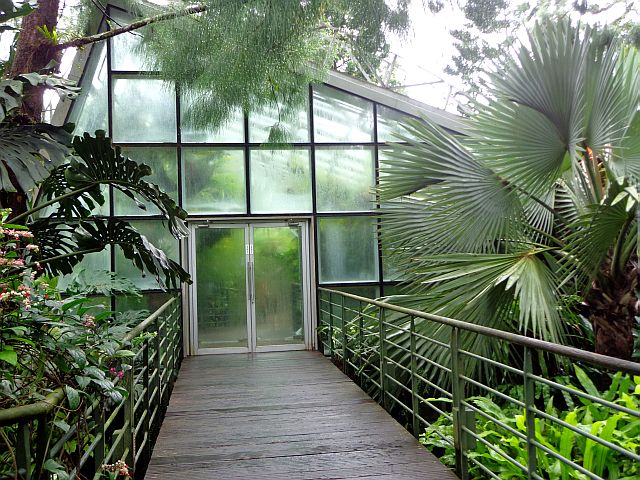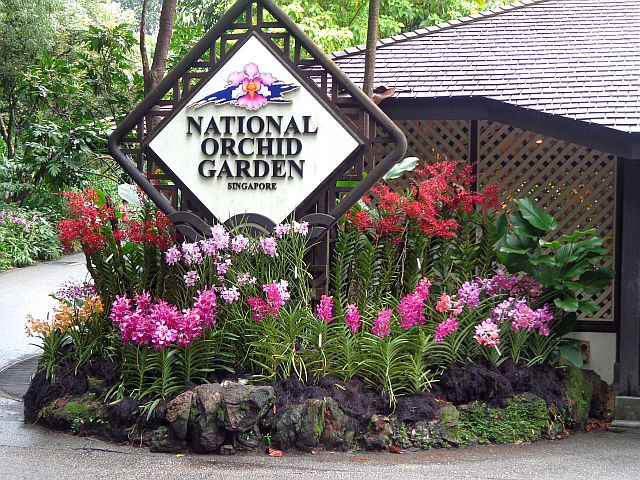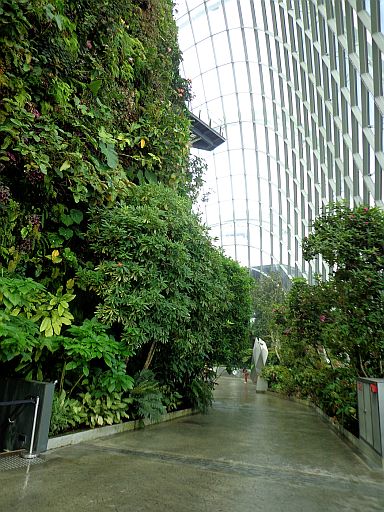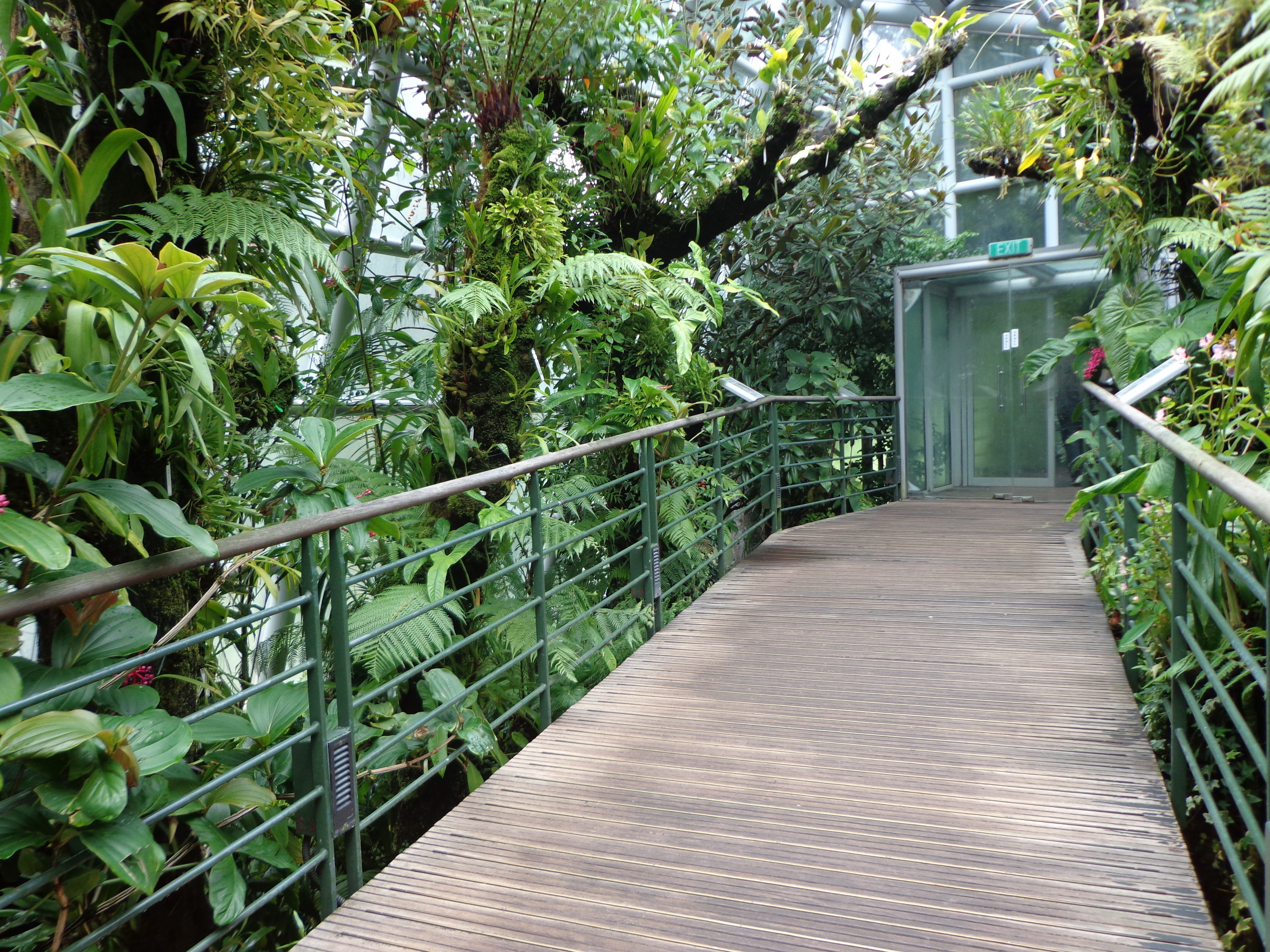
entrance to the Cool House within the Singapore Botanic Garden
CONSERVATORIES started around the 16th century with a special purpose for growing crops, like lemon and oranges (also called orangeries in Europe) and other crops coming from the warmer region of the Mediterranean.
Today, a conservatory is a highly wrought structure both in form and function; moreover, it is a greenhouse. A greenhouse though is a much modest structure that traps the sun’s light energy to be utilized for growing fruits and vegetables. The sun’s radiation trapped inside causes the rise in temperature, which is reflected in the glass panels of its roofs therefore heating the air inside. Plants inside the greenhouse are also protected by outside sudden environmental changes as temperature inside is kept quite constant. Greenhouses are a necessity in the colder
regions of the world.
Botanic gardens around the world usually have conservatories to house their delicate collections of plants that are mostly tropical and exotic species. Since humidity and temperature inside the glass house are controlled, even simulating the ambient temperature of the locality or countries where the plant stock originally came from,it is not unusual to see banana trees, cacao, and if one is lucky, some insect-eating greens like the Philippine native Pitcher plant (Nepenthes sp.), or a Venus fly trap (Dionaea sp.), another carnivorous native plant of the subtropical wetlands of the United States.
So once inside a large greenhouse, one feels he is in some part of a forest. Air is humid and damp. Illuminated by dim greenish light shining through a ceiling of leaves, it’s like entering a tropical rain forest where you would be greeted by an extravagant garden. The moisture all around is necessary and beneficial to the collection of plants mostly brought from the tropics. You would probably know by now why we do not need any conservatories here.
I went to Singapore during the school break to visit the 156-year-old tropical botanic garden. Without asking for directions, I headed towards the nearest MRT station nearest my hotel and took a ticket from a ticket machine and I was on my way to the Bukit Temah gate.
Transportation in this city-state is very efficient. My plan was to walk the whole stretch of the Botanic and to leave the garden from the far end, where the Tanglin gate is located. Obviously, I did my homework prior to visiting the garden to maximize time
for my visit. I had to choose from the many charms and let go of less enticing allures.
I spent almost the whole day perusing its collection as if I was virtually scanning all the plants while going through the trails. I was kind of envious while going through plant species I was familiar with. I examined my memory where I saw this or that particular plant way back home. Some plants we have ignored and taken for granted, some of which are found in our very own backyard — you have no idea how beautiful they are when presented in the garden. These are plants you and I can identify, at least by their common names; after all, Singapore lies within the tropical zone and is only about three hours’ flying time from Cebu.
I went past the Jacob Ballas Children Garden, understandably intended for children to provide unique discovery and learning experiences in a garden setting. I went past three more gardens, the Fragrant, Foliage, Evolution and the Ginger Garden, but went quickly around the Healing Garden and
took some rest while experiencing its tranquil surroundings shapedlike parts of the body. This garden contains 400 varieties of medicinal plants traditionally used in Southeast Asia.
Moving on, I finally reached my definitive destination halfway through the garden to see Vanda Miss Joaquim. Chosen as Singapore’s national flower only in 1981, it’spart of the garden’s permanent showcase. Any visitor will have the chance to see plot after plot of all 1,000 different species and about 2,000 hybrids produced by the garden’s breeding program. I stayed here for the longest time to appreciate and take photos . Here you get to meet orchid hybrids named after state dignitaries and celebrities, like Prince Charles, Nelson Mandela and Jackie Chan, to mention a few. Gloria Macapagal-Arroyo was honored in 2001, and very recently, a hybrid Dendrobium was named after President Duterte during his state visit to Singapore. The garden as well boasts of yet another collection of 300 different species of bromeliads from Central and South America housed in the Yuen-Peng McNeice Bromeliad Collection. A favorite of mine, the yellow dancing ladies, probably thousands of them, weaved into
an arboreal tunnel.
Leaving behind, as if I was not captivated by the sight of the orchid garden, on my way out, one path led me to a glass structure I was almost sure was a conservatory. I was even more amazed upon entering. A quick relief greeted me, a respite from the sticky feel coming from my sweat from hours of strolling. Anair-conditioned garden! Inside the glass structure is a microcosm of a montane tropical forest presented in a realistic demonstration of high elevations site in the tropics, aptly named the Cool House. I stayed here even much longer to cool myself and to dry my wet shirt while trying to understand the physiology ofthe plants native to this kind of settings.
Housed here are several fern species, epiphytes, flowering climbers, our famous pitcher plant, more orchids, and other plants of the cool moist yet again tropical biomes neatly tucked in a naturally designed soil-less medium. A bridge allows the viewer to enjoy the collection which connects the entrance and exit of the building. Moreover, it serves as a visitor’s platform as it’s suspended high enough so one should be able to see plants from beneath as well.
A small gushing waterfall located almost in the middle of this short-span walk-through completes the whole backdrop.
I’m wondering if the Cool House of the Singapore Botanic Gardens is by definition a greenhouse. To enlighten myself, I visited the following day the award-winning Cooled Conservatories of the Gardens by the Bay not very far from the Marina Sands. They have two huge conservatories, one housing their flower dome which boasts of 30,000 plants from over 150 species spread across nine, yes, nine gardens. The other is housing their Cloud Forest, home to 60,000 plants from tropical highlands of up to 2,000 meters above sea level with an
indoor waterfalls and interactive discovery zones.
One can take time to explore and appreciate each plant variety as everything is under the dome where one can experience the cool conditions of subtropical Mediterranean regions. Where else can one see old baobab, gnarled olive trees and rows and rows of blue, purple and yellow tulips under one roof? And one need not go so fast strolling around, unlike the Botanic gardens where the tropical
air after hours of walking gives a languid effect on the body. Here, it is fully air-conditioned!
When I left the Gardens by the Bay, late did I realize that even outside the gardens my experience seemingly extended into
the city streets all the way to my hotel. The whole city itself is landscaped just like a sultry garden.




